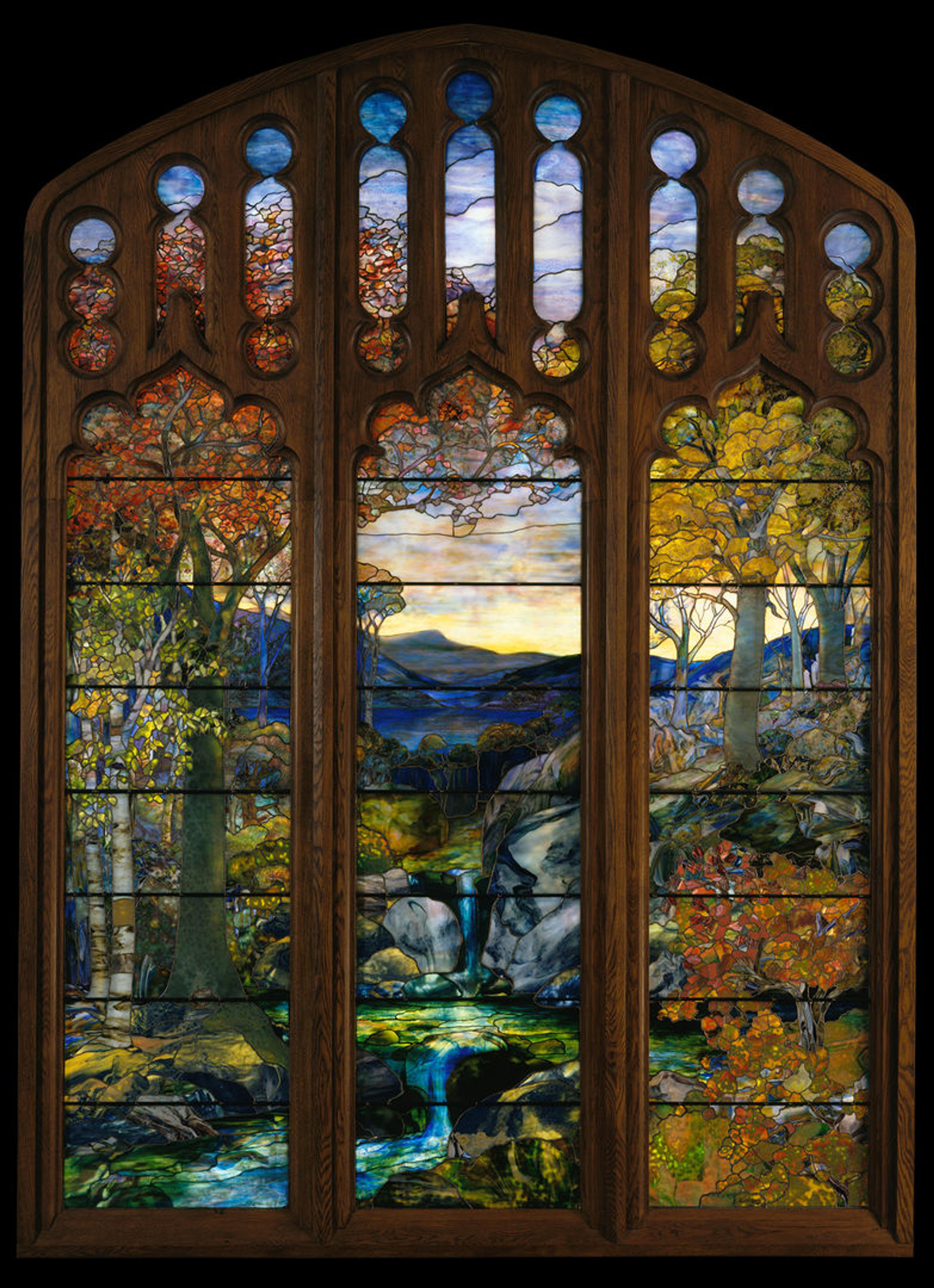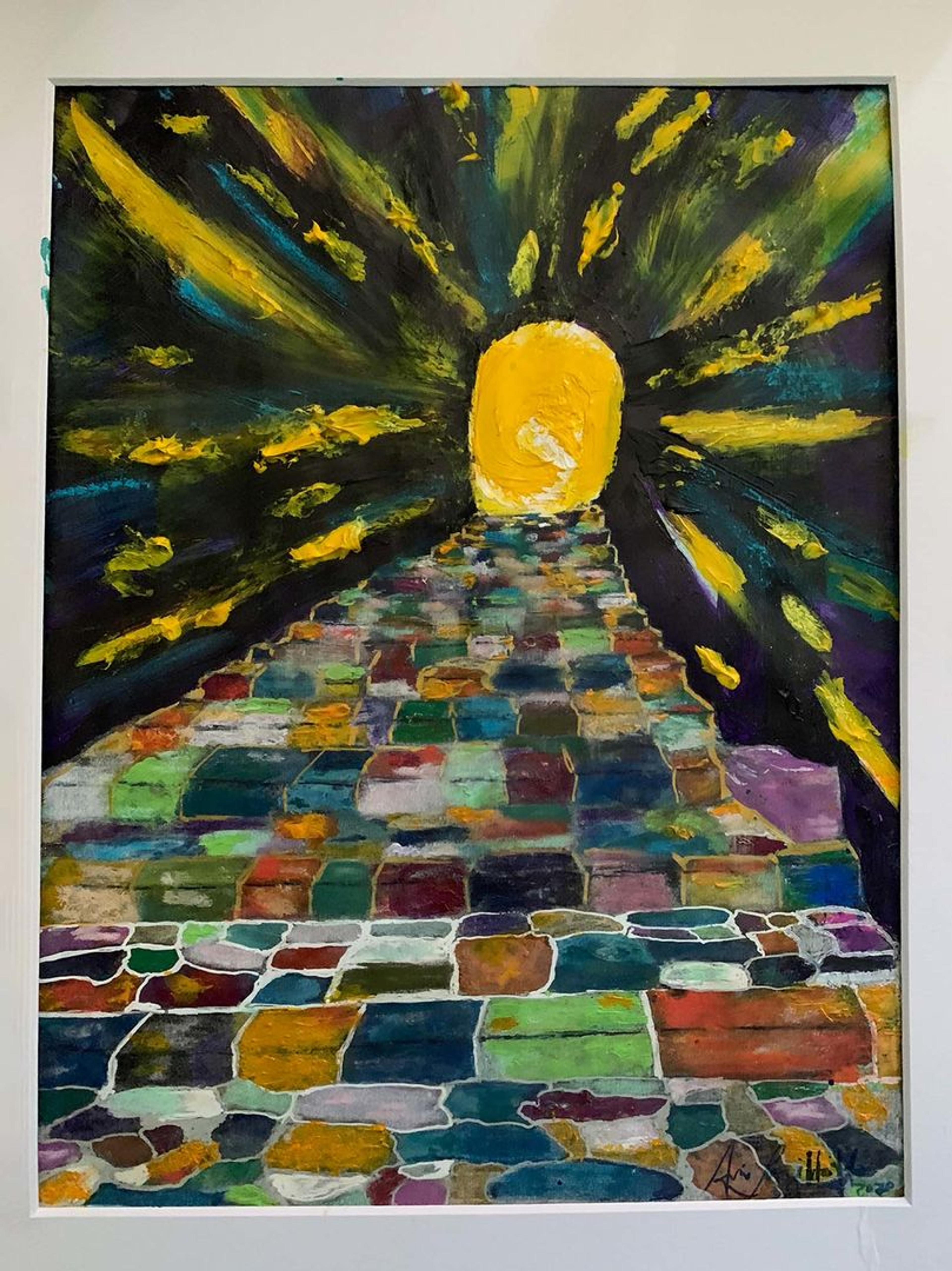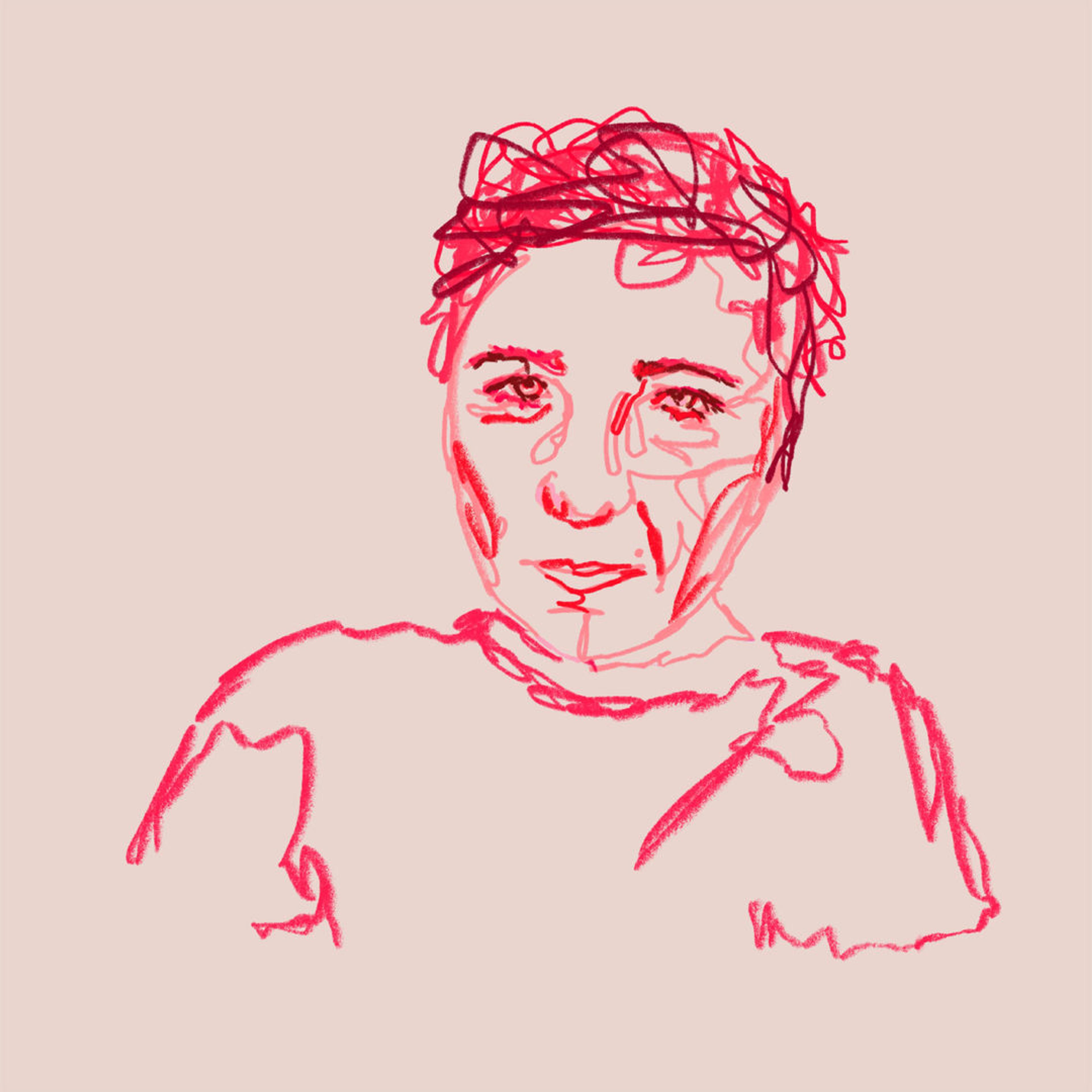How can art help us heal? Imagine an elderly mother and daughter resting on a museum bench, taking in the vivid colors of a stained glass window. When artist and poet Annie Lanzillotto recalls this experience with her mother, it was a moment of peace that helped her make sense of her family and life. Hear how, ever since her childhood in the Bronx, art has remained a powerful tool for inspiration and healing through domestic violence, financial hardship, and multiple cancers.
Listen to the podcast
Healing Through Colors
Subscribe to Frame of Mind wherever you listen to podcasts:
Listen on Apple Podcasts Listen on Spotify Listen on Amazon Music
Transcript
Annie Lanzillotto:
How do we move forward as a society, as, as humans? To elevate each other out of this intense grief. There’s been so much loss. Art does help, telling each other stories helps.
Barron B. Bass:
How can a work of art actually help us heal? Picture an autumn landscape, twelve feet high and made of more than a thousand pieces of glass. Light pours through colorful leaves and the waterfall, filling the room with a warm glow.
Welcome to Frame of Mind, a podcast from The Metropolitan Museum of Art, about how art connects with wellness in our everyday lives.
This week, we'll hear from Annie Lanzilotto, a poet and artist from the Bronx, about what happened when she and her mom sat under a Tiffany stained-glass window at The Met. For her, that moment of connecting with art is one of many throughout her life and informs her thinking about trauma, illness, beauty, and recovery.
Annie Lanzillotto:
In the American Wing, Gallery 700, the Charles Engelhard Court. That’s a gallery that has been very healing for me and my mother. Now, my mother and I were both multiple cancer survivors with lung issues. We sat in Gallery 700 because there were benches there, there was air there. So for people who are healing, you need a place to sit. You need a place to breathe. And you need a place to be still.
So we’re sitting in Gallery 700, there’s beautiful statues all around, there’s Diana in bronze, naked with her bow and arrow. There’s open skylights and there’s Tiffany windows. She was so taken by the stained glass. The most edifying thing for my mother was this Tiffany window with a waterfall. The name of the window was Autumn Landscape (1923–24).

Design attributed to Agnes F. Northrop (1857–1953); made by Tiffany Studios (1902–32). Autumn Landscape, 1923–24. Made in New York. Leaded Favrile glass, 132 x 102 in. (335.3 x 259.1 cm). The Metropolitan Museum of Art, New York, Gift of Robert W. de Forest, 1925 (25.173a–o)
The way the glass is bent into color and layered, it’s a miracle, Like living inside a kaleidoscope. And a work of art like that will make you cry, because it shows you what a human being is capable of.
When I asked my mother how she survived domestic violence and how she maintained her resilience and sparkle, she shocked me with her answer. She said to me, colors.
And now, thinking back at her, mesmerized by this Tiffany autumn landscape. This waterfall with the folded blue colors and the greens and the foliage, the gold, the light. She allowed that into herself, into her soul. She invited it in. And that moment in the light and in those colors was a completely healing, miraculous, transformative experience.
I didn’t know I was working-class at ten years old. Everyone was in the same boat, growing up in the working-class section of the Bronx. We really weren’t exposed to rich people. The word artist seemed out of reach, but art and doing things with beauty and care and making was infused in everything we did.
My father never hired anyone to do anything. He made everything himself. And my mother and grandmother made clothes, they made everything. So there’s art in everything. Every meal was beautiful.
And that sense of possibility has stayed with me.
My mother was a victim of domestic violence at the hands of my father, who had post-traumatic stress disorder from World War II. He survived. But, just because a soldier walks off the battlefield doesn’t mean the war is over. And my mother became, you know, his prime enemy when he was suffering with rage, nightmares, panic, and terror.
She would call the cops, or I would try to call the cops, even when I was three, four years old. The police knew my father as a war hero. And so when the police came, there was really nothing. It’s not what you would have called intervention. So the war continued and it continued in our kitchen, in the Bronx. It continued in the bedrooms and the living room.
So my mother escaped a few times and then moved for good when I was twelve. I mean, we ran for our lives. After she escaped my father, she went back into doing manicures and hair coloring and everything to do with colors, you know? So she was a painter, really a painter of nails, lips, eyebrows. And so color was, and beauty culture was always part of her life. And she was an artist in her own right.

Image of Annie and her mother. Courtesy of Annie Lanzillotto
And I didn’t appreciate beauty culture as an art form, you know, as a young lesbian, I just didn’t understand. But really, in retrospect, I understand that was her healing.
So one day in the nineties, we went to The Met. I was about thirty years old. I was prioritizing taking care of my mother. We went for the city to heal us and take us out of our struggle. We were here to sparkle. There was a special exhibit of chess sets from all around the world. For some reason, this one chess set, Liberty versus Slavery, captivated us.
The pawns were all musicians on the liberty side. It was an internal liberty. And who was internally free? The clarinetist, the drummer, the violinist. And who was internally oppressed? On the other side, I’m going to read you the names of the pawns—sick, wounded, crushed, hopeless, despair, et cetera.
So I’m staring at this chess set, that my memory is a flute player or stringed instrument. Let’s say mandolin or guitar. Chest open, breathing, looking up. My memory of the other side of the chessboard, the oppressed, was looking down, heads hanging down.
What I saw in this chess set was the burden of labor, you know, really you’re a beast of burden and your head’s hanging down. So being a working-class kid in a violent house, I’d say it’s the same thing. Like, it’s hard to lift your head.
What drew me in was—how do I find internal liberty? How do I find internal freedom? This is what captivated me.
Do poor kids need a chance to be alone in front of works of art? Yes. Make it happen. Make a new system of ushering, create opportunities for stillness for working people. When it’s quiet, no big crowds, no one’s rushing you—that’s privilege. And now look at a work of art. You know, your whole soul opens up. And that chess set did that to me.
So the same day we saw the chess set, and we saw the knights, you know, we saw the mummies. We did the whole, we did the exhibits that we could. And we were exhausted. We rested in the atrium. So that’s where we were when we saw them, the stained glass windows that very healing day
Up till March 3, 2020, I was in a vibrant community of actors, theater artists, authors. My life was, you know, small theaters, cafes, and stages. And all that stopped. I am immunocompromised, from not only several cancers but the treatment of those cancers. So when I heard about COVID-19, I knew I was in it for the long haul.
And I thought, “How am I going to get through this alone?” I knew that if I dove down deep into art projects, you know, that would be my submarine to the future. That would carry me through. And I started painting what was around me, which was lemons. There were three lemons on a blue plate on my writing desk. And after three, four weeks of being alone, I realized these lemons were my tactile company.
Each of the lemons has what to me was a little eye. It looked like they were looking back at me. And I picked up a paintbrush. I got yellow paint. I started a series of still lives called, Still Life, Still Life, Life, Still, Still Life (2020). And then I made a painting called, Stepping on Colors (2020).

Image of Stepping on Colors by Annie Lanzillotto. Courtesy of Annie Lanzillotto
So when I was a kid in the Bronx, in the backyard, there was, let’s say cement squares and other shapes. And my father painted these all different colors. So one was red, one was white, one was brown, green, yellow, orange. And as a five-year-old, four-year-old, I would jump from one to the other. So I jumped from let’s say the orange, it felt like a rock, to the yellow rock.
And I imagined from color to color, I was jumping on a whole new place, like a whole new island. And I coached myself through sheltering in place by just saying, step on the next color. Don’t look too far ahead. Just look down at your feet. What do you have to do today? Go from red to gold. Just take that one step.
Colors are my way to get through this period of isolation. Stepping on colors. just as a kid hopped from that red to the orange, to the blue, to the silver, to the gold, just focus on the next step and take it one step at a time. And colors, you know, to take my mother’s message, color’s helped me heal.
Barron B. Bass:
Thank you for listening. This has been Frame of Mind: An Art & Wellness Podcast from The Met. To find out more about Annie and the artworks mentioned in this episode, please visit the Met's website at www.metmuseum.org/frameofmind, where you’ll find bonus articles, features, resources, and videos on the endless connection between art and wellness.
Frame of Mind is produced by The Metropolitan Museum of Art and Goat Rodeo. At The Met: Head of Content Sofie Andersen, Executive Producer Nina Diamond, Associate Producer Bryan Martin, and Production Coordinators Harrison Furey and Lela Jenkins. At Goat Rodeo: Rebecca Seidel is Lead Producer. Megan Nadolski is Executive Producer. Production Assistance from Char Dreyer, Isabelle Kerby-McGowan, Cara Shillenn, and Max Johnston.
Senior producer is Ian Enright. Story Editing from Morgan Springer. Series Illustration by Sophie Schultz. I’m your host Barron B. Bass. A special thanks to our guest on this episode, Annie Lanzilotto.
This podcast is made possible by Bloomberg Philanthropies and Dasha Zhukova Niarchos.
If you liked this episode, please leave us a rating or review and share it with your friends.
Next time on Frame of Mind…
Kisook Suh:
When it comes to repair and mending, it's just a simple manual work. Tedious, it could be, but we can process a lot of difficult ideas in our head by doing so. Those process really helps me going through difficult time that I cannot do anything about.
